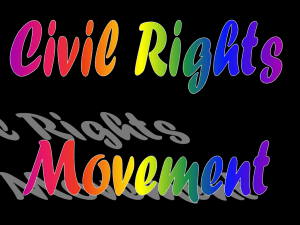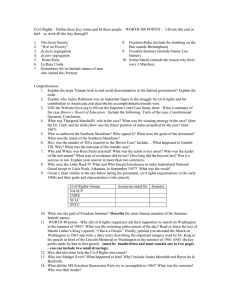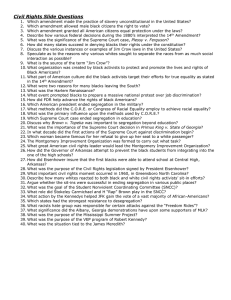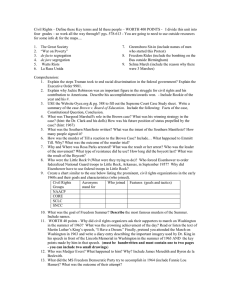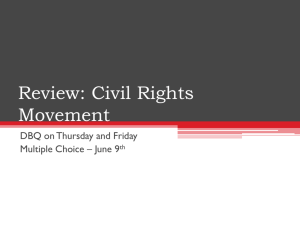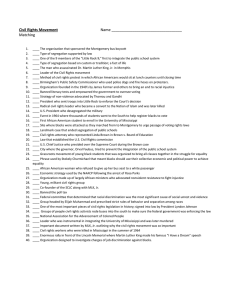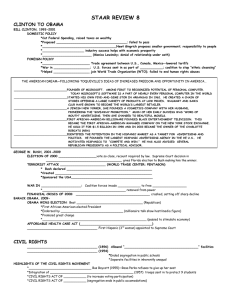1
advertisement
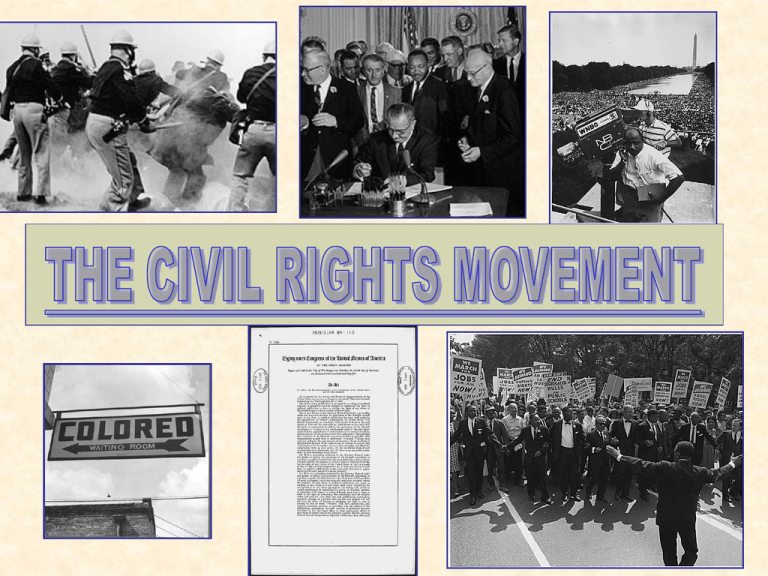
1 The civil rights movement in the United States has been a long, primarily nonviolent struggle to bring full civil rights and equality under the law to all Americans. The movement has had a lasting impact on United States society, both in its tactics, the increased social and legal acceptance of civil rights it brought about and its exposure of the prevalence and cost of racism. The American Civil Rights movement has been made up of many movements, though it most often refers to the struggles between 1945 and 1970 to end discrimination against African-Americans and to end racial segregation, especially in the U.S. South. 2 After the Civil War, the United States expanded the legal rights of African-Americans. The Congress passed, and the states ratified, an amendment ending slavery in 1865. 3 1865 th 13 AMENDMENT = abolished SLAVERY & INVOLUNTARY SERVITUDE throughout U.S. Note: This amendment only outlawed slavery; it did not provide citizenship and equal rights. 4 th 14 1868 AMENDMENT ALL PERSONS born or naturalized in U.S. - including former slaves – are CITIZENS of the U.S. & as “CITIZENS” are thus guaranteed due process & equal protection under the law. = 5 1870 = 15th AMENDMENT VOTING RIGHTS for ALL MALE CITIZENS shall NOT be denied on account of race, color or previous condition of servitude. 6 1919 TO 1935, HARLEM NEW YORK CITY AFTER WWI MANY BLACKS FLED THE SOUTH FOR BETTER ECONOMIC OPPORTUNITIES AND FREEDOM FROM KKK VIOLENCE. HARLEM WAS A POPULAR DESTINATION AND NEW YORK CITY’S BLACK POPULATION SWELLED FROM 30,000 IN 1900 TO 7 OVER 300,000 IN 1930. BLACK ARTISTS, WRITERS, DANCERS, POETS, HISTORIANS, AND MANY OTHERS TURNED HARLEM INTO A CENTER OF CULTURE, CREATIVITY, AND EXPLORATION OF AFRICAN AMERICAN ROOTS, KNOWN AS THE HARLEM RENISSANCE 8 PREPARATION FOR WWII CREATED MILLIONS OF NEW JOBS, HOWEVER DUE TO DISCRIMINATION MANY BLACKS WERE PREVENTED FROM GETTING JOBS A. PHILIP RANDOLPH LEADER OF BROTHERHOOD OF SLEEPING CAR PORTERS UNION RANDOLPH MET WITH FDR TO INFORM HIM OF A MASSIVE MARCH ON THE WHITE HOUSE LAWN IF SOMETHING WAS NOT CHANGED 9 •He was called the most dangerous black in America. •He led 250,000 people in the historic 1963 March on Washington. •He spoke for all the dispossessed: Blacks, poor Whites, Puerto Ricans, Indians and Mexican Americans. A. Philip Randolph •He won the fight to ban discrimination in the armed forces & federal civil service jobs. •He organized the 1957-prayer pilgrimage for the civil rights bill. 10 As a man living in the bread-and-butter world, Mr. Randolph knew that a good weekly paycheck had to be won first. Then, after the children were fed, a better fight could be waged for dignity & self-pride.With this in mind, Mr. Randolph traveled throughout the nation just before World War II, in 1940 and 1941. His mission: unite Blacks against the discrimination, which shut them out of well-paying jobs in the factories. Although many Whites, and even Blacks knocked his efforts in the beginning, his message caught fire. All over the U. S. committees of Blacks were forming to "March on Washington" in protest. Finally, recognizing that Mr. Randolph could not be swayed, President F D R signed an order, 6 months before Pearl Harbor, in June 1941, which called for an end to discrimination in defense plant jobs. Here was the beginning of "fair employment practices " This, the first "March on Washington," never had to be held. The most powerful leader in the world, the President of the U. S., had yielded to the head of the Brotherhood of Sleeping Car Porters.11 AS A RESULT, FDR ISSUES EXECUTIVE ORDER 8802 JUNE 1941 12 AS A RESULT OF EXECUTIVE ORDER 8802 BLACK WOMEN MADE MANY IMPORTANT CONTRIBUTIONS TO THE WAR EFFORT IN WORLD WAR II 13 HISTORICALLY AFRICAN AMERICANS SERVED IN SEGREGATED UNITS IN EVERY U.S. WAR CIVIL WAR 14 SPANISH-AMERICAN WAR WORLD WAR ONE WORLD WAR II ALSO HAD SEGREGATED TROOPS 15 TRUMAN DESEGREGATES THE MILITARY WITH EXECUTIVE ORDER 9981 JULY 26, 1948 16 TIMELINE OF THE CIVIL RIGHTS MOVEMENT 1948-1960 1948 PRESIDENT TRUMAN ISSUED TWO EXECUTIVE ORDERS. ONE INSTITUTED FAIR EMPLOYMENT PRACTICES IN THE CIVILIAN AGENCIES OF THE FEDERAL GOVERNMENT; THE OTHER PROVIDED FOR "EQUALITY OF TREATMENT AND OPPORTUNITY IN THE ARMED FORCES WITHOUT REGARD TO RACE, COLOR, RELIGION, OR NATIONAL ORIGIN." THIS WAS A MAJOR VICTORY FOR CIVIL RIGHTS ADVOCATES IN THE QUEST FOR FULL CITIZENSHIP. 1954 & 1955 BROWN V. BOARD OF EDUCATION OF TOPEKA, KANSAS, SUPREME COURT RULED THAT SCHOOLS MUST BE DESEGREGATED “WITH ALL DELIBERATE SPEED” 1955 ROSA PARKS REFUSED TO GIVE UP HER BUS SEAT TO A WHITE MAN AND WAS ARRESTED. THIS LED TO THE MONTGOMERY BUS BOYCOTT LED BY MARTIN LUTHER KING JR. BUS SEGREGATION WAS RULED UNCONSTITUTIONAL BY THE SUPREME COURT 1957 STRUGGLE FOR INTEGRATION AT CENTRAL HIGH SCHOOL IN LITTLE ROCK ARKANSAS. PRESIDENT EISENHOWER WAS FORCED TO SEND FEDERAL TROOPS TO ENSURE INTEGRATION OF THE SCHOOL. 1957 THE CIVIL RIGHTS ACT OF 1957 MADE IT A FEDERAL CRIME TO INTERFERE WITH THE VOTING RIGHTS OF U.S. CITIZENS. THE CIVIL RIGHTS COMMISSION WAS ESTABLISHED TO INVESTIGATE INFRINGEMENTS 17 OF THIS LAW. Thurgood Marshall Marshall received his law degree from Howard in 1933, & set up a private practice in Baltimore. The following year, he began working with the Baltimore NAACP. His most famous case as a lawyer was Brown V. Board Of Education of Topeka in 1954. The case in which the Supreme Court ruled on May 17, 1954, that “separate but equal" public education was illegal because it could never be truly equal. President Johnson appointed him to the Supreme Court on June 13, 1967. Note: He was the first American Black to be appointed to the Supreme Court 18 Thurgood Marshall 19 Brown V. Board of Education The unanimous ruling which declared that segregation in education was inherently unequal 20 The above picture was taken at a school in Fort Myer, Virginia, shortly after the school was desegregated under the mandate of Brown v. Board of Education of Topeka. Many Southern politicians regarded the decision as a "clear abuse of judicial power" and ten years after the case only one percent of black students in the South attended desegregated schools. 21 1954 White Citizens’ Councils – A group comprised of mainly middle and upper income whites who oppose desegregation form the white citizens’ council in Indianola, Mississippi. Soon chapters spring up throughout the south. The councils use economic and political pressure to achieve their ends. 1954 Hernandez v. Texas: The first Mexican American civil rights case heard and decided by the Supreme Court during the post WWII period, the decision also is the first Supreme Court ruling against discrimination targeting a group other than American Blacks. In it the Supreme Court strikes down discrimination based on class and ethnic distinctions between whites and hispanics. 22 August 1955 Fourteen-year-old Chicagoan Emmett Till is visiting family in Mississippi when he is kidnapped, brutally beaten, shot, and dumped in the Tallahatchie River for allegedly whistling at a white woman. Two white men, J. W. Milam and Roy Bryant, are arrested for the murder and acquitted by an all-white jury. They later boast about committing the murder in a Look magazine interview. The case becomes a catalyst of the civil rights movement. 23 1955 Rosa Parks Rosa Parks, a 42 year-old seamstress and NAACP worker in Alabama, is arrested for refusing to give up her seat to a white person and move to the back of the bus. Rosa Parks act of protest against injustice on the buses, sparked the Montgomery Bus Boycott. 24 Mrs. Parks was arrested as a result of her actions. Subsequently, she was bailed out of jail by E. D. Nixon, the Montgomery representative of the Brotherhood of Sleeping Car Porters and a local leader of the NAACP. Later that evening Nixon was struck with the idea of having Montgomery's black citizens boycott the city's segregated bus system. Other groups, including an organization of black women known as the Women's Political Council, also decided a bus boycott was the best way to respond to the arrest of Rosa Parks. An organizational meeting was held at the Dexter Avenue Baptist Church, and subsequently the minister at that church, the Reverend Martin Luther King Jr., was elected to lead the bus boycott. Montgomery's 40,000 blacks stayed off the city buses for more than a year, vowing not to return until the buses were totally desegregated. Many of the boycotters walked to their destinations. Others rode in car pools or received free automobile rides from volunteer drivers supporting the bus boycott. 25 Boycott lasted 381 days In 1956, The Supreme Court outlawed bus segregation The major accomplishment of the Montgomery bus boycott was that it turned a nonviolent demonstration for racial integration into a national news story. 26 “My feet are tired, but my soul is Rested” 27 It was this news attention that made Martin Luther King Jr., a national symbol of the new black resistance to segregation & enabled him to present to the American people his ideas on the Nonviolent Demonstration as a means of producing political and social change. 28 1957: The Little Rock Nine Although most school districts at least attempted to integrate, some districts tried to avoid it, particularly those in the South. One of the most famous cases of integration was the story of the Little Rock Nine, which took place in Little Rock, Arkansas. Governor Orval Faubus had the National Guard block nine black students from entering Central High in Little Rock because he didn’t want to integrate Little Rock’s schools. President Eisenhower heard of this and sent Federal Troops to protect the nine black students. 29 Three years after the Supreme Court's Brown v. Board of Education decision, which officially ended public-school segregation, a federal court ordered Little Rock to comply. On September 4, 1957, Governor Orval Faubus defied the court, calling in the Arkansas National Guard to prevent nine African American students from entering the building. Ten days later in a meeting with President Eisenhower, Faubus agreed to use the National Guard to protect the African American teenagers, but on returning to Little Rock, he dismissed the troops, leaving the African American students exposed to an angry white mob. Within hours, the jeering, brick-throwing mob had beaten several reporters and smashed many of the school's windows and doors. By noon, local police were forced to evacuate the nine students. When Faubus did not restore order, President Eisenhower dispatched 101st Airborne Division paratroopers to Little Rock and put the Arkansas National Guard under federal command. By 3 a.m., soldiers surrounded the school, bayonets fixed. 30 Little Rock Nine awarded 31 Congressional Gold Medals 32 33 1957 The SCLC is formed: Southern Christian Leadership Conference After the boycott ended, the Southern Christian Leadership Conference was established with the goal of redeeming "the soul of America" through nonviolent resistance. Its main objective was to coordinate nonviolent protests throughout the South. Martin Luther King Jr., served as president of SCLC from its founding in 1957 until his death in 1968. 34 SCLC trained local communities in the philosophy of Christian nonviolence, opened citizenship schools, and registered voters. SCLC sought to put the struggle for civil rights in moral terms. Through the 1960s, under King's leadership, SCLC participated in sit-ins, voter registrations, mass demonstrations, Freedom Rides and antipoverty programs. 35 1960 Sit-ins: Black protestors sit down at segregated lunch counters & refuse to leave until they are served or arrested. 36 5 black students (members of Lane's Student Movement Association) left campus (North Carolina’s Agricultural & Technical College) & entered Woolworth's about 11 a.m. They sat down at the "whites only" lunch counter. Store employees immediately closed the "We don't serve y'all," a waitress snapped. counter. Manager Fred Cook summoned police, who arrested the students and charged them with disorderly conduct and "threatened breach of peace." Bond was set at $50 each. 37 “We decided to go back & be arrested or be served. This time they poured hot coffee down our backs, put out cigarettes on our backs. They threw the boys out one at a time. They took the two girls and threw them bodily from one group to the other before throwing them out. The policemen were watching and did not act." 38 By the late 60’s students organized sit-ins in some 48 cities & 11 states. They endured arrests, beatings, suspensions from college, dogs, tear gas & fire hoses. 39 1961 Freedom Rides: In May of 1961, The Congress of Racial Equality, (CORE) a group of civil rights activists sought to "test" enforcement of a recent Supreme Court decision outlawing segregation in bus terminals & interstate transportation. The group consisted of black & white, male & female. They boarded 2 busses in D.C. & were bound to New Orleans where they would celebrate the 7th anniversary of the Supreme Court's decision in Brown v. Board of Education. Their route would take them through South Carolina, Georgia, & Alabama. At various bus terminals, the black "Freedom Riders" would go to the white dining areas and waiting rooms while the white "Freedom Riders" would go to the area reserved for blacks. The buses were bombed, shot at and attacked by Klansmen. All the protesters were jailed when they reached Alabama. The violence was seen on television across America & again drew40the nation's attention to the civil rights movement. 41 1962 James Meredith & the University of Mississippi In September of 1962, James Meredith sought to enroll as the first black student in the history of the University of Mississippi (Ole Miss). His enrollment triggered substantial resistance from the University, the community of Oxford Mississippi, and the Governor of the state, Ross Barnett. As a result, President John F. Kennedy ordered federal marshals to ensure Meredith's right to enroll and to protect him as he moved to the campus. On the evening of the Meredith's enrollment, President John F. Kennedy spoke to the American people in a live television address. As Kennedy was speaking, violence broke out on the campus and in Oxford. President Kennedy ultimately ordered federal troops to Oxford to quell the riots which injured over 300 and killed two.42 43 April- May 1963: Birmingham, Alabama “Project C” "Project C" was the name given to the plan devised by Martin Luther King and the Southern Christian Leadership Conference to challenge the system of segregation in Birmingham, Alabama. The "C" in the project stood for confrontation, the strategy of nonviolent direct action designed to confront segregation through peaceful demonstrations, rallies, boycotts, and appeals to justice. This strategy actually hinged upon the anticipated reaction of Police Commissioner Bull Connor. Leaders reasoned that the response of Connor and the police would be to suppress the demonstrations, quite likely through violent means. If so, this response to peaceful protest would attract national attention and create public sympathy for the cause of desegregation. The leaders reasoned correctly. The response of Bull Connor was as expected. Police dogs and fire hoses were used to disperse the demonstrators. Martin Luther King was arrested by Birmingham police on Good Friday, April 12, 1963. During his stay in jail, the white ministers of Birmingham churches wrote and urged King to call off the demonstrations and boycotts. The following was King's response: 44 King wrote his letter on scattered strips of paper that a friend smuggled out of jail. The typed version was smuggled back to King and re-smuggled out. The process continued until a 20 page document emerged: I guess it is easy for those who have never felt the stinging darts of segregation to say, “Wait.” But when you have seen vicious mobs lynch your mothers & fathers at whim; when you have seen hate-filled policemen curse, kick, brutalize & even kill your black brothers & sisters…when you see the vast majority of your 20 million Negro brothers smothering in the airtight cage of poverty;…when you have to concoct an answer for a 5 year old son asking…”Daddy, why do white people treat colored people so mean?”… then you will understand why we find it difficult to wait. 45 46 June 11, 1963 George Wallace Stands in the "School House Door" Desegregating the University of Alabama In 1963, the governor of Alabama was George Wallace. He had run for and won the office on the slogan of "segregation now, segregation tomorrow, segregation forever." In June of 1963, a federal court barred any state government interference with the enrollment of two black students, Vivian Malone and James Hood, at the University of Alabama. Despite this order, Governor George Wallace appointed himself the temporary University registrar and stood in the doorway of the administration building to prevent the students from registering. In response, President Kennedy federalized the Alabama National Guard. One hundred guardsman escorted the students to campus and their commander, General Henry Graham, ordered George Wallace to "step aside." Thus were the students registered. 47 48 The events in Alabama, led John F. Kennedy to realize that nothing short of a new civil rights act would satisfy the needs for racial justice. 49 Kennedy Addresses the Nation 6/11/63 On the same evening, President Kennedy addressed the public in a speech broadcast by all television networks. It was a clear break with JFK's prior and lukewarm position on civil rights. The bill that he submitted to Congress was ultimately passed as the Civil Rights Act of 1964. “Are we to say to the world - & much more importantly, to each other – that this is the land of the free, except for the Negro?” 50 June 12, 1963 The Assassination of Medgar Evers Jackson, Mississippi One day after Kennedy's landmark speech, violence struck again. The place was Jackson, Mississippi. The field secretary for the National Association for the Advancement of Colored People (NAACP), Medgar Evers, was leading a protest against Jackson's system of segregation. That evening, Evers arrived home, stepped out of his car, and was shot in the back. He died on his driveway with his wife and children looking on. 51 Byron De La Beckwith (1963 & 1994) Bobby DeLaughter The assassin was white supremacist Byron De La Beckwith, a member of the Ku Klux Klan and a man with an intimidating and violent personality. Beckwith was arrested, tried, and acquitted by an all white jury. Years later, in 1994, Assistant District Attorney, Bobby DeLaughter, reopened the case. This led to a retrial in which the jury convicted Beckwith, 31 years after the act, of assassinating Medgar Evers. The story of Beckwith's second trial 52 is the subject of the 1996 film entitled Ghosts of Mississippi. August 28, 1963 The March on Washington To pressure the government and Congress to act more quickly on the civil rights agenda, a massive march on the nation's capital was planned, scheduled, and carried out on August 28th, 1963. According to estimates, over 250,000 participated in the peaceful demonstration which culminated in the speech given by Reverend Martin Luther King. 53 September 15, 1963 Birmingham Bombing On Sunday morning, September 15, 1963, a bomb exploded in the 16th Street Baptist church in Birmingham, Alabama. The explosion killed four young girls who were in the church for Sunday school and injured another 20 people. The FBI sent agents to investigate and four suspects were identified. The Birmingham office of the FBI recommended that the four be prosecuted. However, the Director of the FBI, J. Edgar Hoover, refused and claimed that civil rights activists themselves bombed the church to gain public sympathy. The FBI initially closed the case in 1968. 54 55 "Dynamite" Bob Chambliss Thomas Blanton Bobby Frank Cherry The suspects were four members of the Ku Klux Klan. It took nearly 40 years for them to be brought to justice. Local prosecutors reopened the case and one suspect, Robert "Dynamite Bob" Chambliss, was convicted of murder in 1977. Herman Cash died in 1994 as charges against him were being prepared. On May 1, 2001, a Birmingham jury convicted Thomas Blanton (62 years old at the time of the trial) on four counts of murder. Finally, on May 22, 2002, a jury convicted Bobby Frank Cherry (now 71 years old) of the murders. Both Blanton 56 and Cherry were sentenced to life in prison. Two months later, on November 22, 1963, an assassin shot & killed John F. Kennedy. His successor, President Johnson, pledged to carry on Kennedy’s work by winning passage of the civil right bill. “We have talked for 100 years of more,” Johnson said. “It is time now to write the new chapter and to write it in books of law.” 57 Civil Rights Act of 1964 Signed by President Lyndon B. Johnson Prohibited discrimination because of race, religion, national origin & gender. It gave all citizens the right to enter all public accommodations: libraries, parks, washrooms, restaurants, theaters, 58 etc Freedom Summer: Meanwhile, In 1964, Civil Rights groups recruited white students from colleges across the U.S., trained them in non-violence resistance techniques to help with getting Blacks registered to vote in Mississippi. They hoped their campaign would receive national publicity that would in turn influence Congress to pass a voting rights act. About 1,000 volunteers – mostly white & 1/3 female 59 Voter project encounters violent opposition: In June, 1964, 3 civil rights workers disappear in Mississippi. Michael Schwerner James Chaney Andrew Goodman 60 FBI Investigators later learn that Klansmen Along with the support of the Mississippi police murdered & buried them in an earthen dam. 61 1965 Bloody Sunday In February of 65, law officers shot and kill a demonstrator named Jimmie Lee Jackson. Dr. King responds by announcing a 50-mile protest march from Selma to the state capital, Montgomery. Alabama. On Sunday, March 7, news bulletins interrupt regular t.v. programs to show what looked like a war. Police and troopers on horseback begin to club and tear gas the marchers. The day becomes knows as “Bloody Sunday. The scene sent shock waves across the country. Demonstrators from all over the country poured into Selma to join the march Marchers from around the country join a second march that resumes that Tuesday, but it is aborted. A week later, the marchers finally reach the state capitol in Montgomery. President Johnson responds by asking Congress for the passage of a new voting right act. In his speech, Johnson embraces the saying of the movement when he states, “Their cause must be our cause, too. It is not just Negroes, but all of us, who must overcome the crippling legacy of bigotry and injustice. And we shall overcome.” 62 63 1965 Because of the passage of the act, the percentage of registered black voters in the South tripled. Voting Rights Act of 1965 Ten Weeks after the Selma –to-Montgomery march, Congress pased the Voting Rights Act of 1965. The act eliminated the literacy test that had disqualified so many voters. The act also stated that federal examiners could enroll voters denied suffrage by local officials. 64 In 1965, the civil rights movement turns to the North: Blacks migrate to northern cities after WWII: White flight: Whites move to suburbs in great numbers By mid 1960’s blacks in northern cities find themselves in slums Schools & neighborhoods are deteriorated Unemployment rate among blacks is twice as high as whites Over the next several years racial riots & violence take place in over 100 cities 65 Malcolm X 66 Malcolm X was born Malcolm Little on May 19, 1925 in Omaha, Nebraska. Considered controversial because of his beliefs: Did not want to integrate Urged blacks to defend themselves whenever they are being unjustly & unlawfully attacked All white people are devils (later changed his belief about 67 this, due to pilgrimage to Mecca, in Saudi Arabia) This is the 27th time I’ve been arrested & I aint goin to jail no more!…We been saying freedom for 6 years and we aint got nothin’ what were gonna start saying now is BLACK POWER! Stokely Carmichael He said that “BLACK POWER” was a call for black people to begin to define their own goals, lead their own organizations, stop recruiting whites in the civil rights movement & focus on developing Black 68 pride Black Panthers Founders: Bobby Seale & Huey P. Newton Organized in Oakland, Ca. in Oct. 1966 to fight against police brutality & racism 69 The group also ran medical clinics and provided free food to school children. Within a couple of years the Black Panthers in Oakland were feeding over 10,000 children every day before they went to school. The Panthers had chapters in several major cities & had a membership of over 2,000. Harassed by the police, members became involved in several shootouts. The activities of the Panthers came to the attention of J. Edgar Hoover & the FBI. Hoover described the Panthers as "the greatest threat to the internal security of the country" & in Nov. 1968 ordered the FBI to employ "hard-hitting counter-intelligence measures to cripple the Black Panthers". 70 Death of Dr.King: April 4th, 1968 71 1968 Dr. King seemed to sense that death was near. On April 3rd, 1968, he addressed a crowd in Memphis, Tennessee, where he had gone to show his support for the city’s striking garbage workers. The next day, King steps out onto the balcony of his hotel room. Across the street, James Earl Ray thrust a high-powered rifle out of a window and squeezed the trigger. King crumpled as a bullet crashed through his neck. An hour later, the man who dared to dream of racial peace lay dead from racial 72 violence. Rage over King’s death led to the worst urban riots in U.S. history. Some 125 cities exploded in flames Cities hardest hit: Baltimore, Chicago, Kansas City & Washington D.C. 73 74 1968: The American Indian Movement (Aim) AIM is founded in Minneapolis, Minnesota, around a philosophy of self determination. It begins to organize communities and create opportunities for Indian people across America and Canada, bringing lawsuits against the U.S. government for the protection of the rights of Native Nations that were previously guaranteed in treaties and the U.S. Constitution. Dennis Banks is the co-founder 75 On March 2nd, 1968, the Kerner Commission, which President Johnson had appointed to study the causes of urban violence, issued a 200,000 word report which said that the main cause was white racism. The report called for the nation to create new jobs, construct new housing & end de facto segregation. De facto segregation – segregation that exists by practice & custom. In 1968, Congress passed the Civil Rights Act of 1968, which banned discrimination in housing 76
